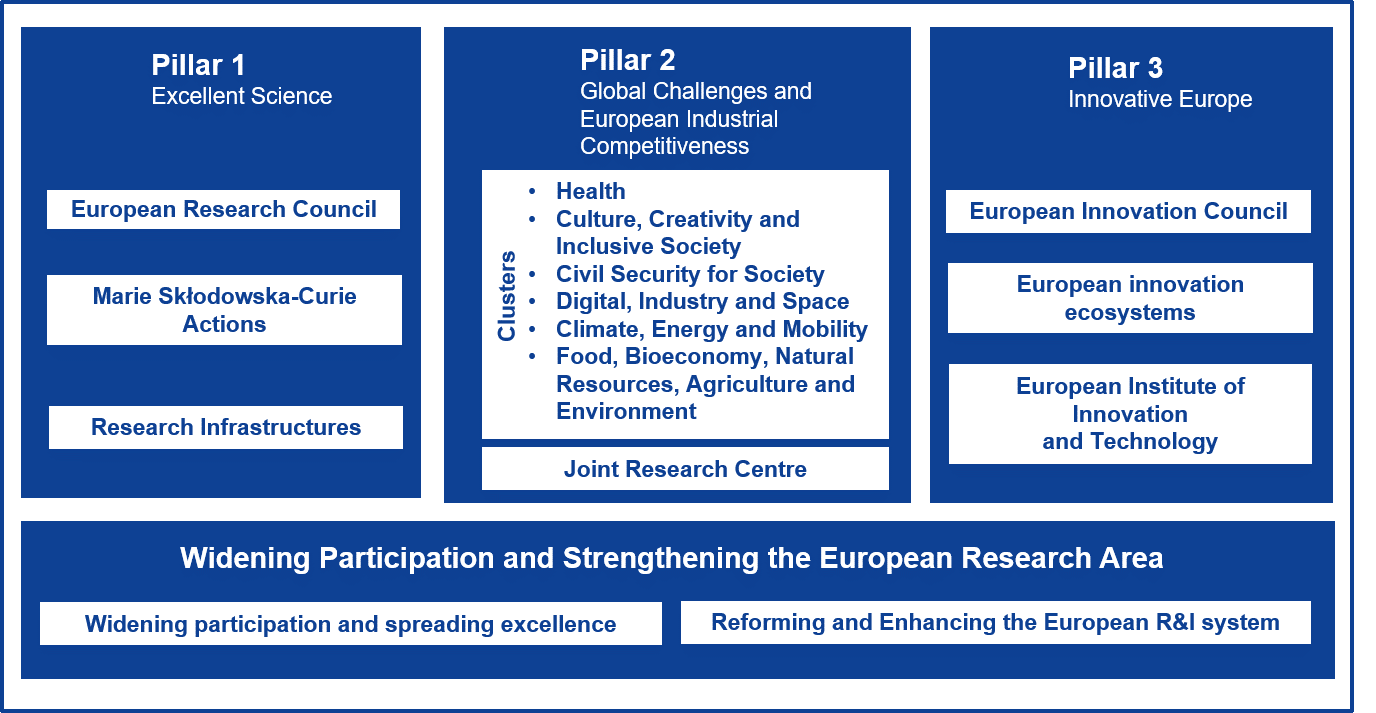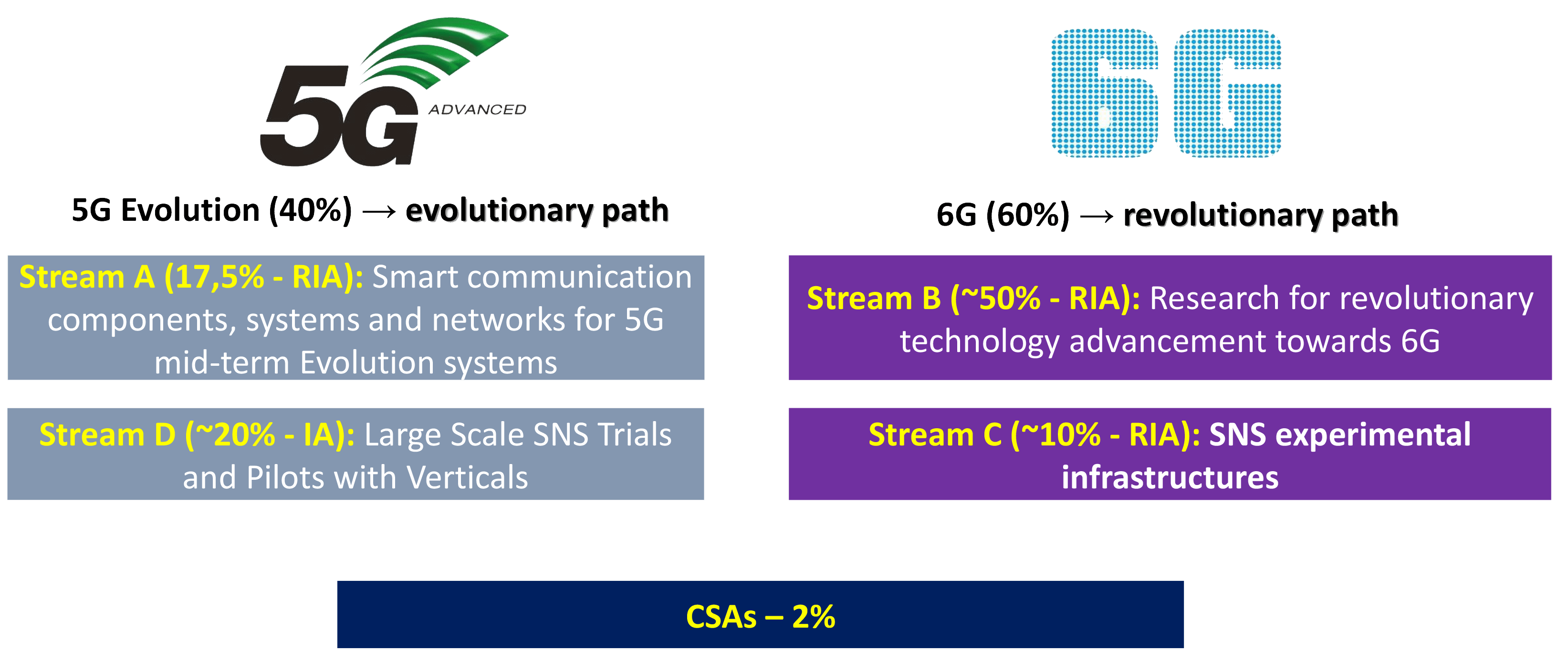EU Funded Research Programmes
Horizon Europe Programme (2021-2027)
Following on from Horizon 2020 (FP8), the Commission has recently launched Horizon Europe (FP9), an ambitious €100 billion research and innovation programme, to run from 2021-2027.
The work programmes for Horizon Europe are available to view and download on the Funding and Tenders Portal.
© European Union, 2019 - European Commission – Preliminary Structure of Horizon Europe, the EU Research and Innovation Programme (2021-27)
The Smart Networks and Services Joint Undertaking (2021-2027)
The recently launched European Smart Networks and Services Joint Undertaking (SNS JU) aims to ensure industrial leadership for Europe in 5G and 6G.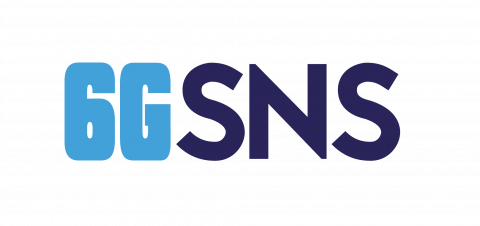
The SNS JU investments will reach at least €1,8 billion for the period 2021-2027, with a €900 million contribution from the EU Horizon Europe programme adequately complemented by industry investments. The SNS JU provides financial support in the form of R&I grants to participants following open and competitive calls.
The key goal of the SNS JU is to secure European leadership in the development and deployment of next generation network technologies and services, while accelerating European industry digitization.
The SNS JU has adopted its first research Work Programme 2021-2022 with an earmarked public funding of about € 240 million. The Call for Proposals sets out four main complementary work streams:
- Stream A: Smart communication components, systems, and networks for 5G Evolution systems.
- Stream B: Research for radical technology advancement (in preparation for 6G and radical advancements of IoT, devices and software).
- Stream C: SNS Enablers and Proof of Concept (PoCs), including development of experimental infrastructure(s).
- Stream D: Large Scale Trials and Pilots with Verticals, including the required infrastructure to explore and demonstrate technologies, advanced applications and services in vertical domains
These four streams will be complemented by Coordinated Support Actions (CSA) to support EU wide synergies and international cooperation.
Digital Europe Programme (2021-2027)
The Digital Europe Programme (DIGITAL) is the EU funding programme focused on bringing digital technology to businesses, citizens and public administrations.
DIGITAL will not stand alone, but rather complements other EU programmes, such as the Horizon Europe programme for research and innovation and the Connecting Europe Facility for digital infrastructure. It is a part of the long-term EU budget, the Multiannual Financial Framework, which covers the period of 2021 to 2027.
The work programmes for DIGITAL are available to view and download on the Funding and Tenders Portal.
Horizon 2020 Programme (2017-2020)
Horizon 2020 was the EU Research and Innovation programme running from 2014 to 2020. It was the eighth such Framework Programme (FP8). For more information see https://ec.europa.eu/programmes/horizon2020/what-horizon-2020.
6G Smart Networks and Services Industry Association (6G-IA)
6G-IA is the voice of European Industry and Research for next generation networks and services. Its primary objective is to contribute to Europe’s leadership on 5G, beyond 5G and SNS/6G research. The 6G-IA represents the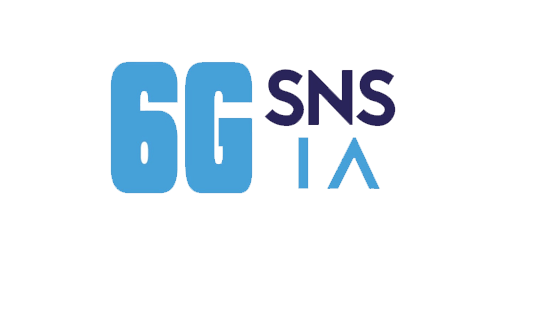 private side in both the 5G Public Private Partnership (5G-PPP) and the Smart Networks and Services Joint Undertaking (SNS JU). In the 5G-PPP and SNS JU, the European Commission represents the public side. The 6G-IA brings together a global industry community of telecoms & digital actors, such as operators, manufacturers, research institutes, universities, verticals, SMEs and ICT associations. The 6G-IA carries out a wide range of activities in strategic areas including standardization, frequency spectrum, R&D projects, technology skills, collaboration with key vertical industry sectors, notably for the development of trials, and international cooperation.
private side in both the 5G Public Private Partnership (5G-PPP) and the Smart Networks and Services Joint Undertaking (SNS JU). In the 5G-PPP and SNS JU, the European Commission represents the public side. The 6G-IA brings together a global industry community of telecoms & digital actors, such as operators, manufacturers, research institutes, universities, verticals, SMEs and ICT associations. The 6G-IA carries out a wide range of activities in strategic areas including standardization, frequency spectrum, R&D projects, technology skills, collaboration with key vertical industry sectors, notably for the development of trials, and international cooperation.
NetworldEurope
NetworldEurope is the European Technology Platform (ETP) for communications networks and services, that follows on from NetWorld2020 in the Horizon Europe programme.
NetworldEurope has over 900 members representing principally researchers from the communications systems sector, industry leaders, innovative SMEs, and leading academic institutions. NetworldEurope drives the community discussions on the future research technologies for ICT, in order to provide guidance for the development of the future European Union R&D program.
NetworldEurope Strategic Research and Innovation Agenda (SRIA) provides a long-term view about the future of telecommunications in Europe and is developed in cooperation with the 5G-Infrastructure Association (5G-IA). It collects the views from industry and academia, and has received inputs from Alliance for Internet of Things Innovation (AIoTI) and from the Networked European Software and Services Initiative (NESSI). The SRIA may be downloaded here
As a follow up to the SRIA, NetworldEurope developed an Annex (SMART NETWORKS IN THE CONTEXT OF NGI) for the purpose of providing an auxiliary summary to the development of the future work programme for the Smart Networks and Services Joint Undertaking (SNS JU). The annex may be downloaded here.
ETSI works in close cooperation with NetworldEurope and together we have built a mapping between the research topics described in the NetworldEurope SRIA and the current ETSI work programme.
The mapping below shows the NetworldEurope SRIA technical domains mapped to the most appropriate ETSI or 3GPP standards activities. By clicking on the appropriate research topic it is possible to access the more detailed sub-topics and the mapping to the public information of the corresponding standards activities.
Mapping table between research topics in NetworldEurope and in current ETSI work programme
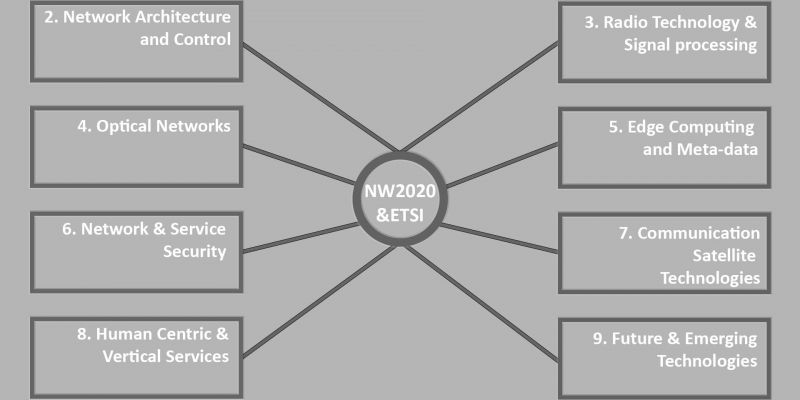
3.1 Spectrum Re-farming and Reutilisation - 3GPP RAN and 3GPP RAN5
3.2 Millimetre Waves - 3GPP SA1
3.3 Optical Wireless Communication - 3GPP SA1
3.4 Terahertz Communications - 3GPP SA1
3.5 Ultra-Massive MIMO - 3GPP SA1
3.6 Non-orthogonal Carriers - 3GPP SA2
3.7 Enhanced Modulation and Coding - 3GPP SA2
3.8 Improved Positioning and Communication - 3GPP SA2
3.9 Random-Access for Massive Connections - 3GPP SA2
3.10 Wireless Edge Caching for Further Increased Throughput - 3GPP SA1
4.1 Flexible Capacity Scaling - 3GPP SA2
4.2 New Switching Paradigms - 3GPP SA3
4.3 Deterministic Networking - 3GPP SA3
4.4 Optical Wireless Integration - 3GPP SA3
4.5 Optical Network Automation - 3GPP SA3
4.6 Security for Mission Critical Services - 3GPP SA3
4.7 Ultra-high Energy Efficiency - 3GPP SA3
4.8 Optical Integration 2.0 - 3GPP SA3
5.1 Beyond Mobile Edge Computing - 3GPP SA3
5.2 Future Directions for Fog Computing
5.2.1 Cloud Computing: Friend or Foe? - 3GPP SA3 and 3GPP SA45.2.2 Fog Computing - 3GPP SA5
5.2.3 Fog Computing Research Directions - 3GPP SA5
5.3 Massive IoT Services
5.3.1 Critical IoT services - 3GPP SA55.3.2 Scalable management of massive deployments - 3GPP SA6
5.3.3 Distributed/autonomous and cooperative computing - 3GPP SA6, ISG CIM, ISG ENI
5.4 Data Analytics and Data Monetisation
5.4.1 Big Data - ISG MEC5.4.2 Distributed Ledgers - ISG MEC
5.4.3 Artificial Intelligence/Machine Learning (AI/ML) - ISG MEC, ISG mWT, ISG NFV
5.4.4 Lack of awareness and knowledge in personal data monetisation - ISG NFV
5.4.5 Fraud mitigation in data monetisation - ISG NFV
7.1 Overall Vision - oneM2M
7.2.1 Multimedia Delivery - oneM2M7.2.2 Broadband Access - oneM2M
7.2.3 Mobile Broadband to Users and Vehicles - OSG OSM
7.2.4 Machine Type Communication (M2M and IoT) - OSG OSM
7.2.5 Reliable and Critical Communication - OSG OSM, TC BRAN, TC CYBER
7.2.6 Other Applications - TC CYBER
7.3 Ground Segment
7.3.1 Physical layer 63 - TC DECT7.3.2 Network Operations - TC DECT, TC EMTEL, TC ERM
7.3.3 Content Delivery Optimisation - TC HF, TC INT, TC INT (AFI WG)
7.4 Space Segment
7.4.1 HTS Broadband GEO - TC INT (AFI WG)7.4.4 Highly Flexible Payloads - TC INT (AFI WG)
7.4.5 Nano-Systems - TC INT (AFI WG)
7.5 Communication Architectures
7.5.1 Virtualisation and Network Cloudification - TC INT (AFI WG)7.5.2 Enabling Networking for NGSO (Non-Geostationary Satellite Orbit) Systems - TC INT (AFI WG)
7.5.3 Optimised Content Delivery - TC INT (AFI WG)
7.6 Convergence with Heterogeneous Networks
7.6.1 Joint Radio Resource Management (RRM) - TC LI7.6.2 End-to-End Content Delivery - TC MSG
7.6.3 Security - TC MSG, TC MSG TFES
7.6.4 Integrated Network Managment - TC MSG TFES, TC RRS
8.1 Digital Service Transformation - TC SES
8.2 From Software-Centric to Human-Centric Services - TC SES
8.3 Services Everywhere, Infrastructure No Limits - TC SES
8.4 Network-Unaware Vertical Services - TC SES
8.5 Extreme Automation and Real-Time Zero-Touch Service Orchestration - TC SES
8.6 Service Injection Loop - TC SES
9.1 The Physical Stratum: Communication and Computing Resources
9.1.1 Nano-Things Networking - TC SmartM2M9.1.2 Bio-Nano-Things Networking - TC SmartM2M
9.1.3 Quantum Networking - TC SmartM2M
9.2 Algorithms and Data
9.2.1 Impact of AI/ML on the Network9.2.2 Impact of IoT on the Network
9.2.3 Impact of Blockchain Technologies on the Network
9.2.4 Evolution of Protocols
9.3 Applications
9.3.1 Application Level Networking9.3.2 Applications (Components) in the Network
9.3.3 Applications Making Specific Demands to the Network
Bringing the results of Research Projects into ETSI
Research projects funded by such programmes as Horizon Europe, SNS JU, Digital Europe and H2020 are not legal entities and the ‘projects’ themselves may not become a member of ETSI, nor can they provide contributions in the name of the ‘project’ to ETSI committees.
However, the ideal path is for ETSI members that are present in those research projects to contribute elements of the research results directly in to ETSI technical groups, as contributions in the member's own name. They may indicate the origin of their contributions by acknowledging in their contribution documents that the work comes from a specific research project.
If there is no ‘existing home for the research results in ETSI it is always possible to create a new group to welcome the research topics and community. This is typically done using such groups as ISGs (Industry Specification Groups).
With many H2020 projects now concluding and others just beginning, there are multiple opportunities for interaction between research and standards:
- With H2020 research projects that are already finalized, in particular for exploitation of the project results via standards
- With H2020 research projects that are currently ongoing and may address topics of relevance and interests to ETSI
- With future Horizon Europe, SNS JU and Digital Europe research projects that may address topics of relevance and interests to ETSI
Should you have any questions or require further guidance on how to bring research results into ETSI, please contact research@etsi.org.
ETSI’s participation in Research Projects
ETSI as an organization does not generally join a research project as a contractual partner.
However, project proponents may contact ETSI directly should they wish to include relevant activities addressing standardization in the project proposal.
For cases where project consortia wish to establish strong links with ETSI’s technical work, ETSI may, under specific conditions, provide a “letter of support” which confirms ETSI’s interest in the relevant standardization project outcomes. The ETSI CTO considers each request on a case-by-case basis.
In exceptional circumstances, where the linkage between the project and ETSI standards work is expected to be significant, ETSI representative may participate to the project advisory committees. This offers an opportunity to have a regular exchanges with relevant projects and provide guidance on potential standards activities.
ETSI representatives may also participate to research conferences, project coordination and cluster meetings.
This provides an opportunity to meet and network with project leaders and Commission staff as well as providing feedback on the opportunities for standardization activities for innovative research topics.
Should you have any questions on ETSI’s participation in research projects or related topics, please contact research@etsi.org.

